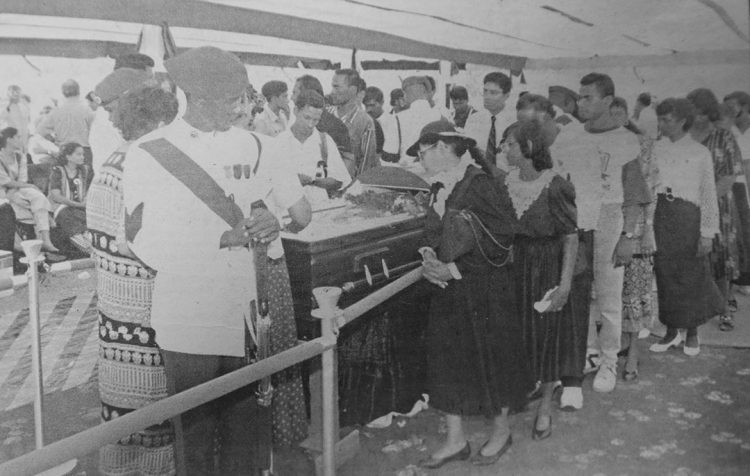(Reprinted from the Souvenir Edition, Monday, March 17, 1997)
Tens of thousands of Guyanese from all walks of life converge on State House and at the Albion Sports Complex ground between March 8-12, to pay their final respects to the late President, Dr Cheddi Jagan.
Filing quietly past the earthly remains of the former head of state in two single lines, they were received by members of the Jagan family, who took turns in keeping vigil over the casket.
Standing sentry with the family were soldiers from the Joint Services, who stood with bowed heads at the four corners of a red carpet on which a black-draped catafalque had been set.
The glassed-top casket and surrounding area in the grounds of State House were protected from the elements by a white tent canopy, but the people who lined up to say farewell had no such covering under which to shelter. Undeterred by the showers of rain they queued patiently to take their turn to view the body.
The stillness of the occasion was occasionally punctuated by open sobbing or a Hindi song of mourning. “God like he more than we,” one elderly woman wailed, crying that she wanted to tie a rakhie on her President’s hand for the last time. Overcome, she was eventually helped to a chair by Nadira Jagan-Brancier, the late President’s daughter.

Dignitaries, politicians and members of the diplomatic corps mingled with people of all ages, races, religions and occupations to pay their respects. There were school children in uniform, toddlers who had to be lifted by their parents for a glimpse of the late President, infants in arms, nurses garbed in their white dresses, groups of workers wearing tee shirts identifying their organization, and Amerindian captains who had been flown in specially from the interior; they all came. For two days, almost without break, they filed slowly past the casket at State House.
The story was the same in Berbice. The late President’s remains had been driven along the East Coast road on Monday, past throngs of villagers who greeted the procession with flowers, flags, portraits, and sometimes tears.
It was in his own home county, however, that the real reception was. Here a veritable forest of placards, flowers and flags met the cortege, which made its way past the flickering diyas and candles which mourners had placed by the side of the road or held in their hands.
Along the Corentyne highway the largest motorcade ever seen in that portion of the country formed behind the funeral procession, and at the Albion Sports Complex, where the body was due to lie in state prior to cremation, thousands of people had gathered waiting to pay their respects.
After some initial disorder, as Berbicians attempted to position themselves to get to the head of the line, the situation was brought under control, and thereafter, the vast throng was disciplined and quiet.
Clearly taken unaware by the large numbers who wished to view the body, and with insufficient time remaining to allow them all to do so, the late President’s family took a decision to postpone the cremation from March 11 to March 12
Janet Canto, a Berbician said: “We were expecting this. He had two days in Georgetown. Why would his hometown not have him for one day.” Many others expressed similar sentiments.
Barbara Kinston of Corriverton was in the line at Albion for five hours before seeing the body of her late president. “We never saw Dr Jagan in our life,” she said, speaking for herself and a friend who was with her, “But he was a great man.”
However, not everyone who came to the Sports Complex Ground was from Berbice. Canecutters Mohan Ramcharran of Leonora, Rajesh of Catherina, Mohabeer of Stewartville and three other friends had left their West Coast Demerara homes at 6 am that morning to view the President’s remains.
“He struggle for we. He is a great hero. We can’t forget him,” Ramcharran said as his friends nodded in agreement.
Seventy-eight-year-old Finee was in the line since eight am, and reached the casket at about 1.30 pm. She said she had seen Dr Jagan in life, although she had never met him, and was very sad at his death.
All day long mourners crossed on the ferry, and all day long GuySuCo trucks and some which were privately owned shuttled people between New Amsterdam and Albion free of cost. At the Sports Complex two lines of mourners, mostly dressed in black, stretched from the ground for about three miles east and a mile west. It was the largest gathering anyone could ever remember.

